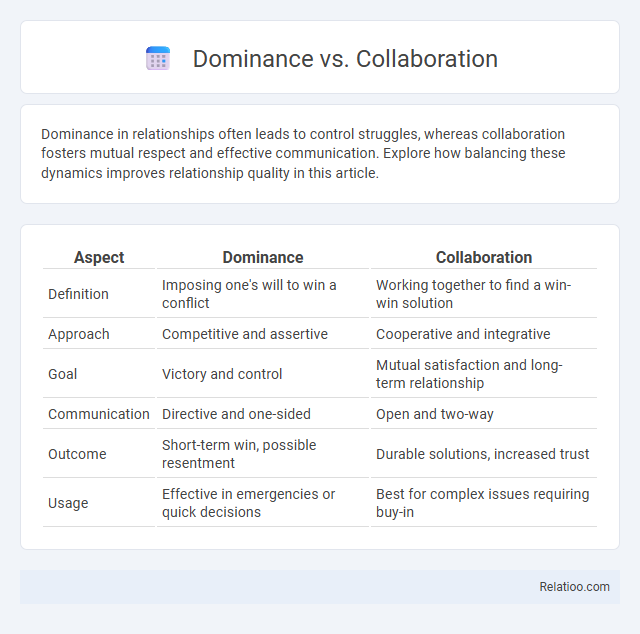Dominance in relationships often leads to control struggles, whereas collaboration fosters mutual respect and effective communication. Explore how balancing these dynamics improves relationship quality in this article.
Table of Comparison
| Aspect | Dominance | Collaboration |
|---|---|---|
| Definition | Imposing one's will to win a conflict | Working together to find a win-win solution |
| Approach | Competitive and assertive | Cooperative and integrative |
| Goal | Victory and control | Mutual satisfaction and long-term relationship |
| Communication | Directive and one-sided | Open and two-way |
| Outcome | Short-term win, possible resentment | Durable solutions, increased trust |
| Usage | Effective in emergencies or quick decisions | Best for complex issues requiring buy-in |
Understanding Dominance and Collaboration
Understanding dominance involves recognizing how power dynamics influence decision-making and communication patterns within teams, often leading to assertive control and competitive behavior. Collaboration emphasizes mutual respect, shared goals, and cooperative problem-solving, promoting inclusivity and collective success. Your ability to balance dominance with collaboration enhances team effectiveness by leveraging strengths while fostering open dialogue and trust.
Historical Perspectives on Leadership Styles
Historical perspectives on leadership styles show dominance often characterized by authoritative control and command, prevalent in military and industrial eras. Collaboration emerged as a response to the limitations of dominance, emphasizing teamwork, shared decision-making, and mutual respect, especially during the rise of knowledge-based economies. Understanding your leadership style evolution helps navigate between dominance and collaboration, optimizing effectiveness in diverse organizational contexts.
Key Characteristics of Dominance
Dominance emphasizes assertiveness, control, and decisiveness, with key characteristics including a strong desire to lead, quick decision-making, and a focus on results over relationships. Individuals high in dominance often prioritize achieving goals and overcoming challenges, exhibiting confidence and risk-taking behavior. Their communication style tends to be direct and authoritative, aiming to influence and drive action efficiently.
Core Principles of Collaboration
Core principles of collaboration emphasize mutual respect, open communication, and shared goals to foster a cooperative environment where everyone's input is valued. Effective collaboration relies on trust, active listening, and a willingness to compromise to achieve collective success. Your ability to prioritize these principles over dominance ensures stronger teamwork and sustainable solutions.
Psychological Effects of Dominance and Collaboration
Dominance in interactions often triggers stress responses, reducing trust and increasing anxiety, which can impair decision-making and personal well-being. Collaboration fosters psychological safety, enhances empathy, and promotes mutual respect, leading to higher motivation and improved mental health outcomes. Your ability to balance dominance and collaboration directly influences team dynamics and emotional resilience.
Comparing Workplace Outcomes
Dominance in the workplace often leads to quicker decision-making but may cause reduced team morale and hinder long-term collaboration. Collaboration fosters higher employee engagement, creativity, and sustainable problem-solving, resulting in more positive workplace outcomes. Your team's success depends on balancing assertive leadership with cooperative approaches to maximize productivity and innovation.
Dominance vs Collaboration in Team Dynamics
Dominance in team dynamics often leads to hierarchical decision-making where one member exerts control, potentially stifling creativity and open communication. Collaboration fosters equal participation, encouraging diverse ideas and shared responsibilities that enhance problem-solving and innovation. Balancing dominance and collaboration ensures efficient leadership while maintaining team cohesion and mutual respect.
Case Studies: Successes and Failures
Case studies reveal that dominance-driven approaches often yield quick decisions but can lead to resistance and long-term failures, while collaboration fosters inclusive problem-solving and sustainable success, especially in diverse teams. Successes in collaborative environments highlight improved innovation and employee engagement, demonstrated by companies like Google, whereas dominance strategies in firms such as Uber have faced criticism for culture issues and high turnover. Your choice between dominance and collaboration should align with organizational goals and culture, learning from both successful and failed case studies.
Choosing the Right Approach for Your Organization
Choosing the right approach for your organization depends on understanding the dynamics between dominance and collaboration. Dominance emphasizes control and decision-making efficiency, while collaboration fosters innovation and teamwork through shared input. Balancing these strategies optimizes organizational performance by aligning leadership style with your company culture and goals.
Building a Balanced Leadership Strategy
Balancing dominance and collaboration in leadership enhances team performance by integrating assertive decision-making with open communication. Your leadership strategy should foster a culture where dominance drives clear vision and authority, while collaboration encourages diverse input and shared goals. Effective leaders adapt their approach to leverage the strengths of both styles, ensuring sustainable success and innovation.

Infographic: Dominance vs Collaboration
 relatioo.com
relatioo.com